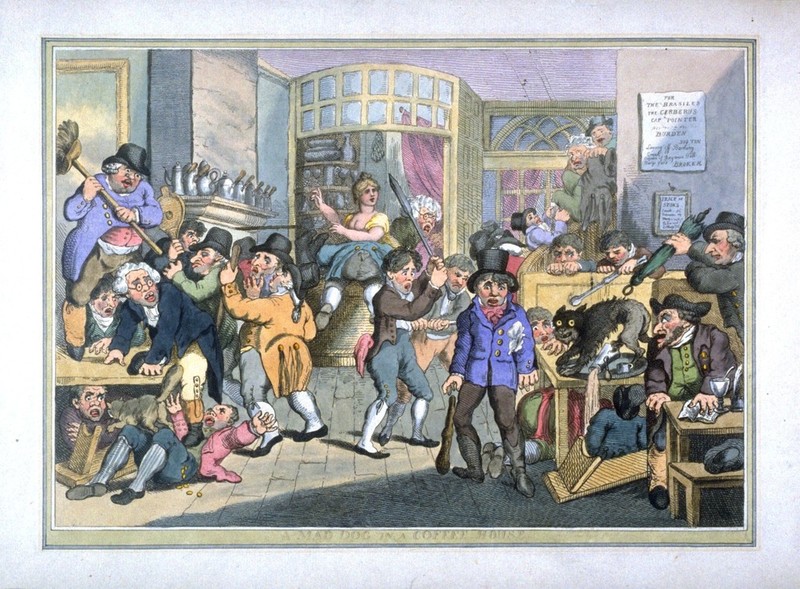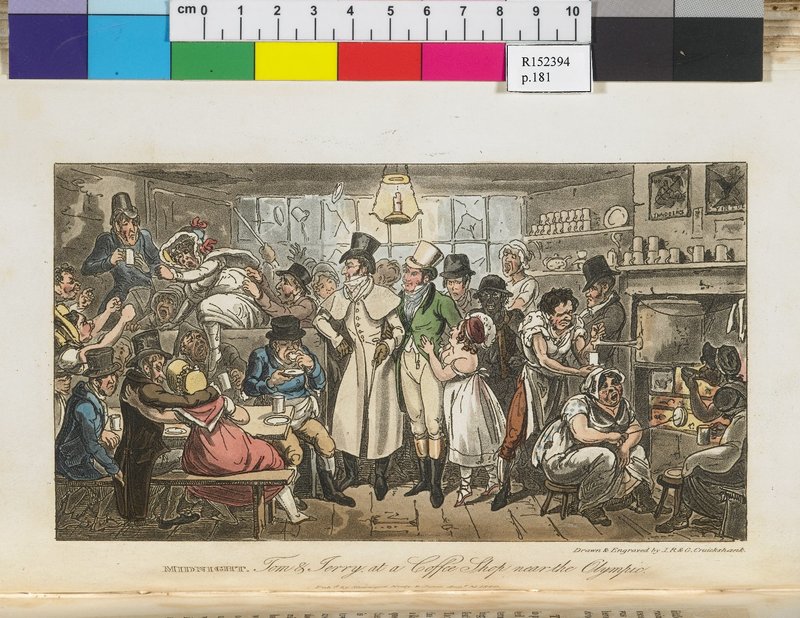To Be Or Not to Be Effeminate (1750-1830)
Once the coffeehouse became an established part of English society, satire was used in paintings to emphasize the differences between the societal expectations for men and women. When the two genders are shown to be in close proximity to each other, these differences are exaggerated. This painting, “A Mad Dog in a Coffee House”, shows a large number of men running away from a rabid dog that has entered the coffeehouse. The black dog with big, yellow eyes, stands on one of the tables and spills a pot of liquid that is most likely coffee onto one of the men. Some of the men use sticks and umbrellas to keep the dog away from them. All of the men’s faces are cartoonish and exaggerated with shock and fear. One beautiful, blonde woman in a yellow dress is behind the bar, serving coffee. A man jumps head-first over the bar to hide in her skirts. A sign on the back of the wall states the “price of stoks” and “broker” which most likely means this coffee house was mainly for stockbrokers. The amount of wealth the men hold is emphasized by the coins falling out of man’s pocket as he lays on the floor crying. The artist is Thomas Rowlandson, a printmaker who was well-known for satire and produced this during his lifetime which stretched from 1756 to 1827 (Royal Academy of the Arts: “Thomas Rowlandson”).
This painting was most likely designed to criticize the people who go to coffeehouses. Most of the men in the painting are running away from the dog, so it may be saying that they are cowards. This could also be showing that the woman is brave because she is the only person whose face is not caricatured by fear. In comparison, the men are acting in an effeminate manner by reacting to the dog with extreme fear. One man even jumps over the counter, where the woman is, to seek protection. Instead of women being used to emphasize masculinity in coffeehouses, as seen in other images, here a woman is used to emphasize and therefore criticize feminine characteristics in men.
Effeminacy was a concern for English men in the early 1700s (Cowen 230). The term was used “to criticize a variety of perceived masculine vices and inadequacies. It was not exclusively associated with homosexuality, as is often assumed” (Cowen 230). The newspapers the Tatler and the Spectator ridiculed men who “devoted too much to the presentation of self, and especially to putatively trivial (and feminine) matters like fashion, exhibitionism, overdecorous ceremony, and the protocols of politeness” (Cowen 230). Susie Steinbach, a Professor of History at Hamline University, wrote that by the late 1700s women were engaging with the male-dominated sphere of politics (Steinbach 225). Effeminacy was still looked down upon and was “synonymous with incompetence” (Steinbach 223). The men in the painting are shown to be incompetent at dealing with the mad dog. The dog seems to represent how out of control the feminine qualities have become within these men because its yellow eyes match the yellow of the woman’s dress. Within this coffeehouse, a place associated with masculinity, a dangerous, rabid dog is running wild. This parallels how the feminine traits are causing havoc within these men.
In comparison, "Midnight: Tom and Jerry at a Coffee Shop Near the Olympic" has two men in top hats standing together at the center of the drawing. Many men and women surround them in chaos. A woman tugs on the man on the right’s suit. She is significantly shorter than the man and is touching him in a way that could be considered sexual. A different woman climbs over the rest of the crowd and her mouth is frozen open amid a yell. One white woman and one black woman sit next to the fire and cook food. The painters, Robert and George Cruikshank, were brothers who both drew illustrations and did etchings. George Cruikshank was very well known for his satirical work (National Portrait Gallery, (Isaac) Robert Cruikshank). They created this illustration in 1821 for a fictional book called Life in London: or, The Day and Night Scenes of Jerry Hawthorne, Esq., and His Elegant Friend Corinthia Tom, Accompanied by Bob Logic, the Oxonian, In Their Rambles and Sprees Through the Metropolis by Pierce Egan. The women in this image are shown as cooking by the fire, which reflects traditional gender roles. The woman in the center of the illustration is also significantly shorter than the man she is next to, which may be trying to convey that she is lesser than he is and is there to serve him. This depiction of women shows what society considers to be masculine and feminine.
Also, the woman on the left side of the painting and the woman in the center of the painting are both touching the men next to them. This could be perceived by the viewer as sexual. The men who frequented coffeehouses found “the serving woman was one of the attractions. Celebrating this flirtatious interaction confirmed the heterosexual interests of the clientele” (Ellis 110). One coffeehouse, King’s Coffeehouse, was run by a widow named Moll King who ran her coffeehouse like a brothel (Ellis 111-112). This painting seems to be portraying a similar coffeehouse which has many women present to give attention to the men. All of these characteristics portray men in a more favorable light than women, in comparison to the previous painting which put the woman in a more favorable light than the men. Both paintings, however, hold the opinion that a man’s place in society is in a position of power over women.


